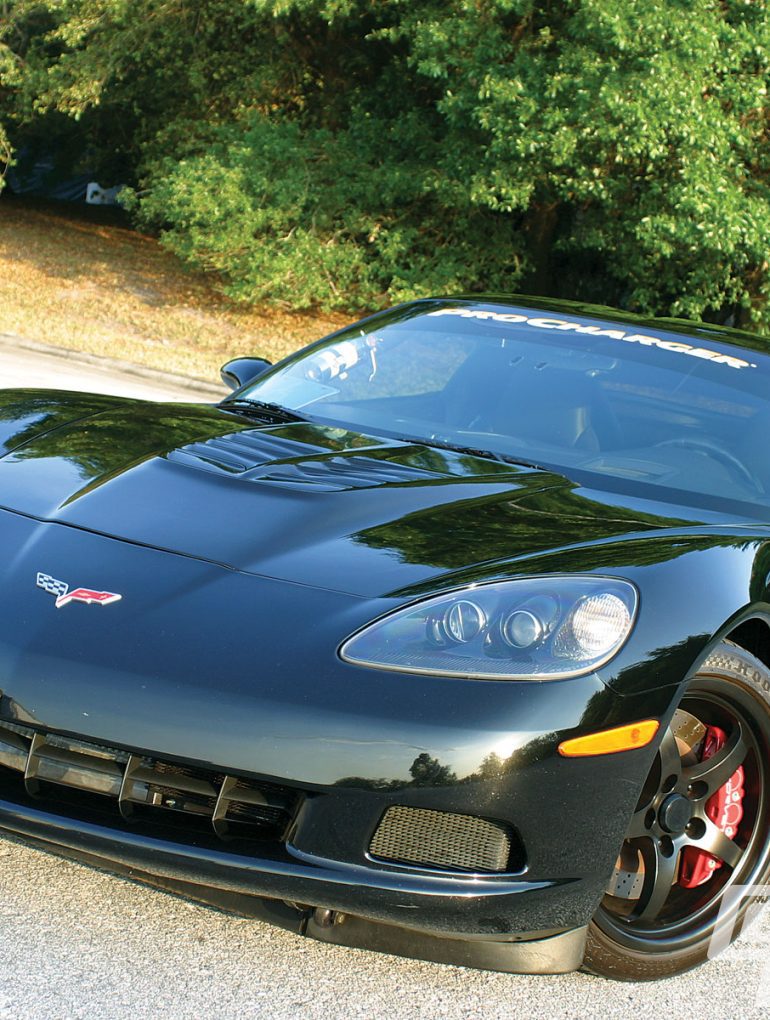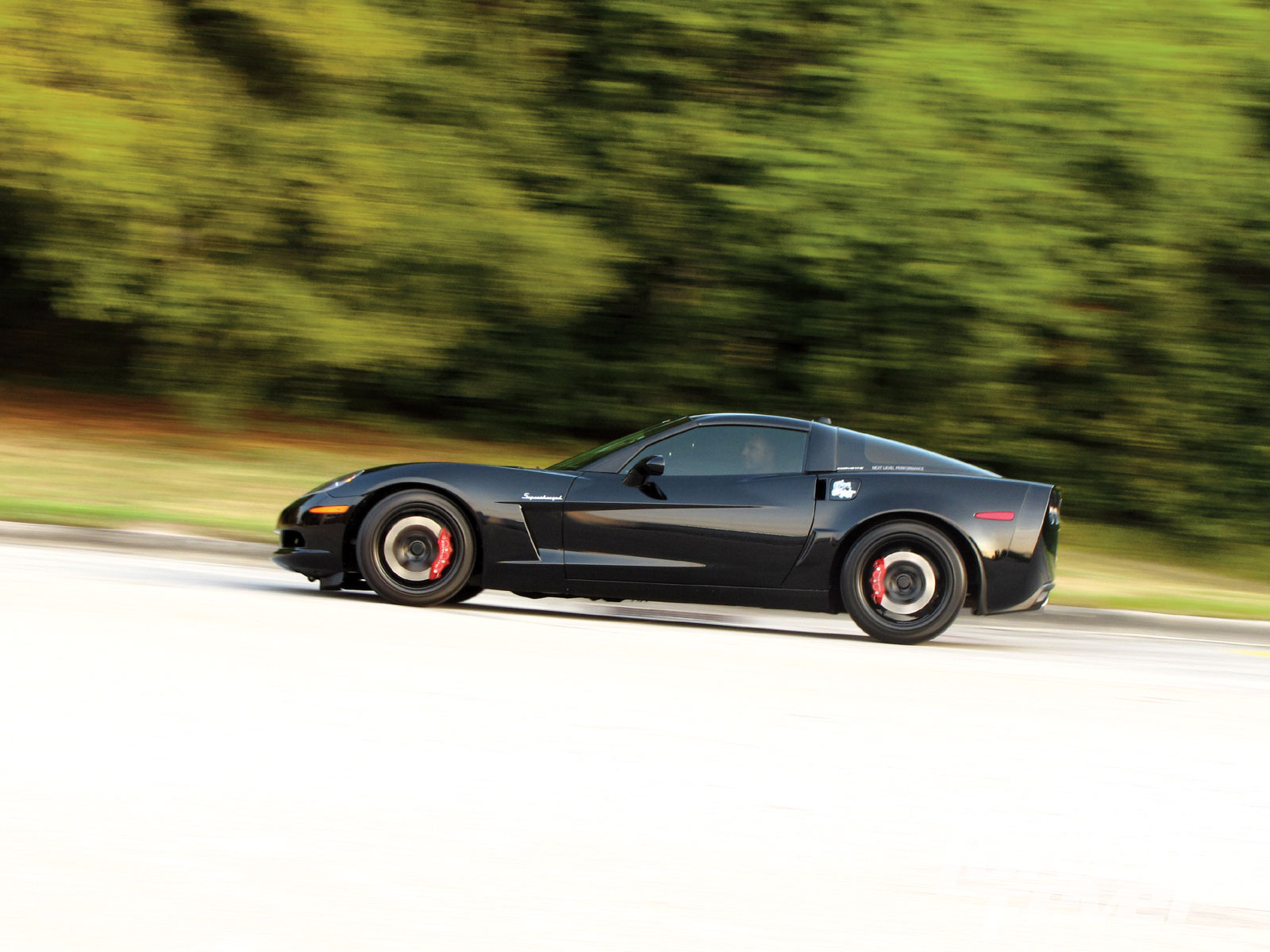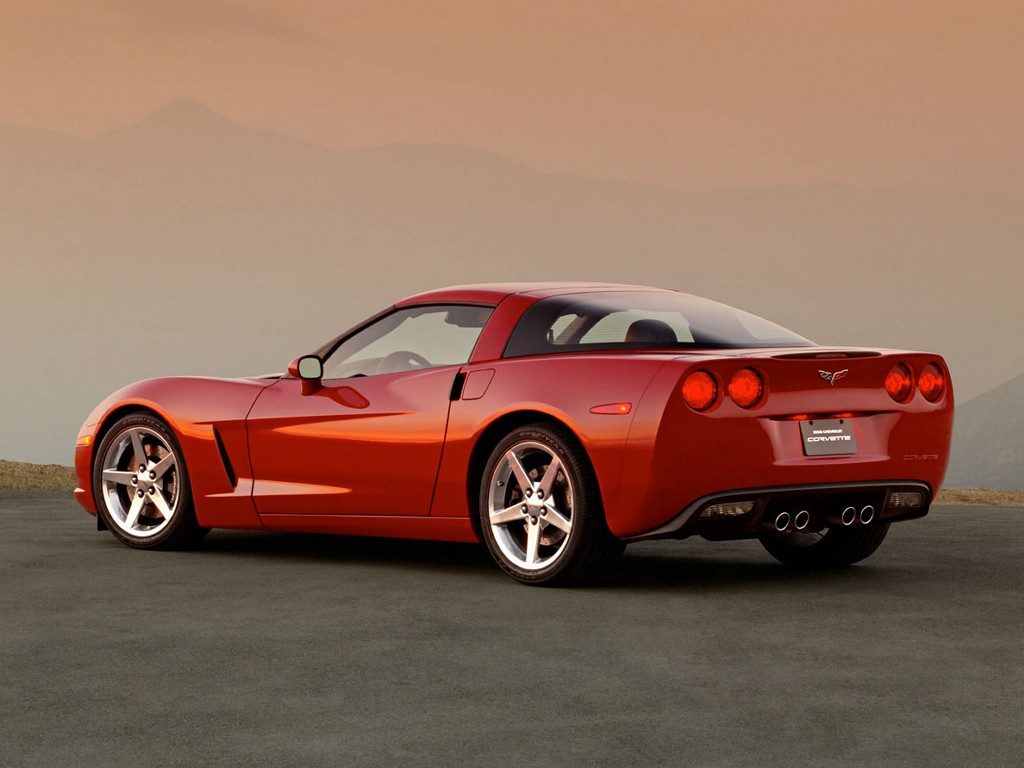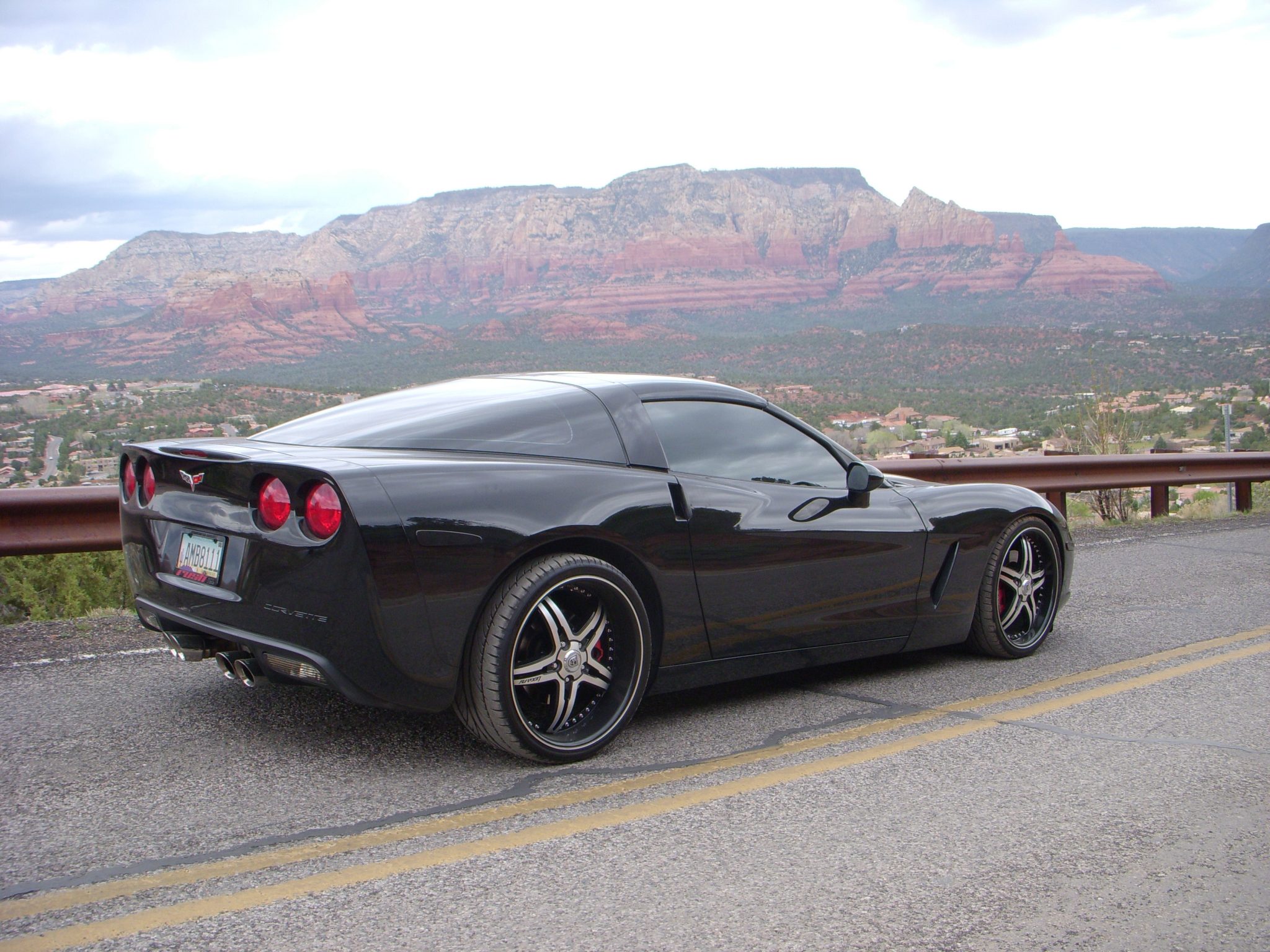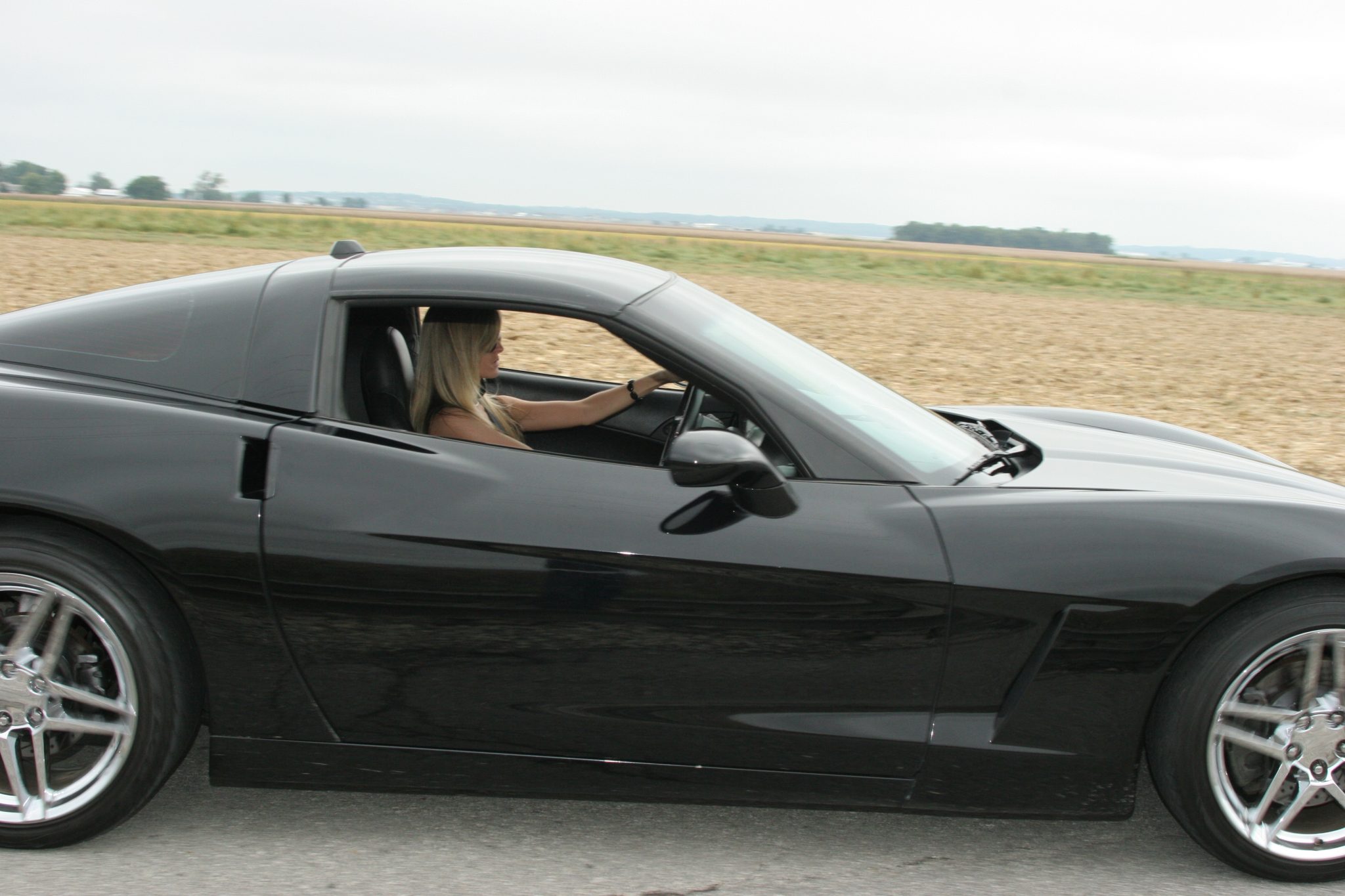2005→2013 Chevrolet Corvette
Marking the sixth generation of its legacy, the 2005 Chevrolet Corvette delivers more power, passion and precision to reach a new standard of performance car excellence. It will be introduced at the North American International Auto Show in Detroit in January 2004, with production slated to begin in the third quarter. A convertible version will be unveiled in the first half of 2004, with its production beginning in fall 2004.
The sixth generation Corvette blends technical sophistication with expressive style. Five inches shorter than the current car, the 2005 Corvette cuts a tighter, more taut profile – with virtually no loss of usable space. More than just visual, the new dimensions make the car more agile and tossable, with upgrades in handling, acceleration and braking. At 0.28 coefficient of drag, the C6 is the most aerodynamically efficient Corvette ever and has improved anti-lift characteristics that enable improved high-speed stability and confidence.
Z51 Performance Package. The Z51 Performance Package brings Corvette Coupe performance very close to the same level as the widely admired Z06. The Z51 offers more aggressive dampers and springs, larger stabilizer bars, and larger, cross-drilled brake rotors for optimum track performance capability while still providing a well-controlled and comfortable ride. Extensive racetrack testing reveals that a C6 equipped with the Z51 suspension almost equals the lap time of a C5 Z06 – marking a major advance in the overall performance of a Corvette Coupe by nearly approximating the extreme performance capabilities of the vaunted Z06 at a remarkable value.
LS2 Powertrain
GM today announced the new 2005 Corvette will feature the most powerful standard engine ever in Corvette history: the 400 horsepower, 6.0-liter, small-block V-8. The new 6.0-liter LS2 is part of the fourth generation of GM’s small-block engines. The small-block debuted in 1955 with 265 cubic inches and 195 horsepower. Since then, this legendary family of engines has been an integral component of Corvette’s performance history.
Compared to the Gen III-based LS1, the LS2 incorporates several significant changes that help improve performance, reliability and serviceability:
-All-new aluminum block casting incorporates provisions for external knock sensors and revised oil galleries; external sensors improve serviceability
-Cylinder bore diameter increased to 101.6 mm (4.00 inches), increasing displacement to 6.0 liters
-Flat-top piston design with lower ring tension reduces friction
-Piston floating wrist pins help quiet the engine
-Revised exhaust manifolds are 33 percent lighter
-Compression raised to 10.9:1
-Engine redline raised to 6500 rpm
-Revised and more powerful engine mototronics incorporate all electronic throttle control functions.
The Tremec T56 six-speed manual is standard and the Hydra-Matic 4L65-E four-speed automatic is optional.
Corvette engineers thoroughly revised the Tremec gear box and added proprietary technology not offered on other automakers’ high-performance transmissions. The six-speed transmission also has revised gearing when selected with the Z51 performance option. With the Z51, the Tremec is tailored with numerically higher gears to improve acceleration. Also, a lower fifth gear gives the Z51 better fuel efficiency and a higher top speed than base models. To increase durability in sustained high-speed situations, the Z51 and the base European manual-transmission models have a transmission cooler.
The available automatic transmission in the C6 is the new Hydra-Matic 4L65-E four-speed. An upgraded version of the C5’s 4L60-E, the L65 is strengthened and revised to accommodate the LS2’s 400 lb.-ft. of torque.
Suspension
Corvette C6 is the result of lessons learned from C5-R’s successes on the track combined with fresh thinking about what a 21st century sports car should be. As the next logical step in the evolution of GM’s Performance Cars Architecture, it takes its robust and real-world-validated backbone structure and enhances it with completely new suspension components.
While the foundation has been enhanced, every suspension component that attaches to it has been changed – none of the suspension bits have been carried over from C5. The short-long arm and transverse leaf spring independent suspension design remains, but the control arms, springs, dampers, bushings, stabilizer bars, and steering gear are completely redesigned. The Extended Mobility Tires (EMT) are also new, taking advantage of the latest compound technology for run-flat capabilities, and play a critical role in the tuning of the suspension for maximum handling and a comfortable ride.
Three suspension choices allow drivers to choose the setup that best suits their style of driving. Each of the choices (Corvette Standard, Magnetic Selective Ride Control, and Z51 Performance Package) provides outstanding handling, but each also offers drivers the ability to tailor the car’s handling traits to specific preferences.
The Standard suspension is tuned for a balance of ride comfort and precise handling. The optional F55 Magnetic Selective Ride Control suspension adds to the Standard suspension magneto-rheological dampers that are able to detect road surfaces and adjust the damping rates to those surfaces almost instantly for optimal ride and body control.
The optional Z51 Performance Package is a competition-ready system for the true performance enthusiast. It offers more aggressive dampers and springs, larger stabilizer bars, Goodyear Supercar tires with an asymmetrical tread pattern, and larger, cross-drilled brake rotors for outstanding handling performance that is still comfortable for daily driving. Beyond the suspension bits, the Z51 is a total system that takes the regular C6 to near-exotic levels of performance. It features gear ratios borrowed from the previous Corvette Z06 for maximum acceleration performance, and includes coolers added for the transmission and power steering systems for aggressive, track-oriented use. The result is a car that very nearly equals the Z06 in track performance – representing a tremendous value.
Robust Brakes
The C6 brake system focuses its improvements chiefly on heat dissipation and durability requisite of the car’s upgraded overall performance capability. For the Standard and F55 Magnetic Ride configurations, the brake rotors remain the same diameter as the C5, at 12.8 inches in front and 12.0 inches in the rear. However, the rotors themselves have been thoroughly redesigned. The front rotors weigh 2 pounds more than the C5, aiding durability. They also generate less heat against the brake pads, which improves wear and reduces fade. In all brake applications, the front calipers utilize dual pistons and the rears use single pistons.
The Z51 Performance Package extends the Corvette’s braking capability with larger diameter rotors (13.4 inches in front and 13.0 inches in rear) that are cross-drilled.
Luxury
Interior materials are significantly upgraded for comfort and aesthetics. The instrument panel and doors are covered with cast-skin foam-in-place trim that is soft to the touch with low gloss to minimize glare. To the eye, it looks like a leather-wrapped, padded panel. To the touch, it is warm and inviting. This advanced material has double the life of conventional automotive paneling materials, resists fading and sun damage, and minimizes interior fogging, which can occur as plasticizers migrate out of the material. Aluminum trim plates with a woven-type tactile surface add richness and emphasize features.
The traditional, easy-to-read analog gauges of C5 provided an excellent starting point for C6’s designers to refine and enhance. White-on-black numerals inform the driver with clean, straightforward displays for speedometer, tachometer, oil pressure, water temperature, voltage, and fuel level. To reduce visual clutter, major telltales were moved from within the dominant tachometer and speedometer gauges to the area between them.
A menu-selectable head-up display is projected onto the windshield in front of the driver with vehicle speed and other information. The display is focused so that it aligns with the driver’s line of sight on the road ahead, allowing the driver to focus on driving while still being able to monitor vehicle speed and other critical vehicle information.
There are two settings for the HUD: Street and Track; and each setting is preprogrammed to display information that is relevant for each respective – and very different – situation. In Street mode, the driver can select between several configurations that feature the speedometer and the turn signal indicators, and then add to it other information such as audio system data, automatic transmission gear position, and high-beam indicator. In Track mode, there is a larger tachometer, a speedometer, engine condition gauges, and a real-time lateral accelerometer that samples and displays the maximum g-force experienced during a turn. The HUD uses LCD pixels to construct the alphanumeric characters and graphics, allowing the HUD to change size and shape.
The removable-roof panel is 15 percent larger, yet offers the same structural stiffness as C5’s while weighing just one pound more. The roof panel comes standard painted body color, or is available with optional tinted clear or with a dual-roof package. With new indexing side-window glass and redesigned seals, Corvette is much more free from wind noise, too. And the many improvements in tires, suspension, and body structure yield impressive reductions in road noise, while improving overall quality perception and making long trips that much more pleasurable.
Images
Videos
In Detail
| tags | c6c |
| submitted by | Richard Owen |
| type | Series Production Car |
| production years | 2005 – 2013 |
| built at | Bowling Green, Kentucky, USA |
| engine | Cast Aluminum V8 |
| position | Front Longitudinal |
| valvetrain | OHV, 2 Valves w/Cyl |
| fuel feed | Sequential Fuel Injection |
| displacement | 5970 cc / 364.3 in³ |
| bore | 101.6 mm / 4.0 in |
| stroke | 92 mm / 3.62 in |
| compression | 10.9:1 |
| power | 298.3 kw / 400 bhp @ 6000 rpm |
| specific output | 67.0 bhp per litre |
| bhp/weight | 277.78 bhp per tonne |
| torque | 542.33 nm / 400 ft lbs @ 4400 rpm |
| body / frame | Composite Body Panels over Hydroformed Steel Frame w/Aluminum & Magnesium Structural Components |
| driven wheels | RWD w/Electronic Traction Control |
| front tires | P245/40ZR-18 Goodyear Eagle F1 SC |
| rear tires | P285/35ZR-19 Goodyear Eagle F1 SC |
| front brakes | Discs w/ABS |
| rear brakes | Discs w/ABS |
| front wheels | F 45.7 x 21.6 cm / 18 x 8.5 in |
| rear wheels | R 48.3 x 25.4 cm / 19 x 10 in |
| steering | Rack & Pinion w/Speed Sensitive Power Assist |
| f suspension | Wishbones w/Upper & Lower Control Arms, Transverse Composite Leaf Spring, Monotube Shock Absorbers |
| r suspension | Wishbones w/Upper & Lower Control Arms, Transverse Composite Leaf Spring, Monotube Shock Absorbers |
| curb weight | 1440 kg / 3175 lbs |
| wheelbase | 2886 mm / 113.6 in |
| front track | 1577 mm / 62.1 in |
| rear track | 1542 mm / 60.7 in |
| length | 4435 mm / 174.6 in |
| width | 1844 mm / 72.6 in |
| height | 1246 mm / 49.1 in |
| transmission | 6-Speed Manual |
| gear ratios | 2.97:1, 2.07:1, 1.43:1, 1.00:1, 0.71:1, 0.57:1 |
| final drive | 3.42:1 |
| top speed | ~289.7 kph / 180 mph |


